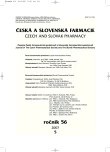Determination of valproic acid by on-line coupled capillary isotachophoresis with capillary zone electrophoresis with conductometric detection
Stanovení kyseliny valproové pomocí on-line spojení izotachoforézy a kapilární zónové elektroforézy s vodivostní detekcí
Cílem práce bylo otestovat vhodné podmínky pro stanovení VPA v séru metodou ITP-CZE s vodivostní detekcí. Zjišťovalo se, zda pro metodu popsanou Ölveckou et al. se dá použít podobná příprava vzorku jako pro metodu plynové chromatografie, která se rutinně používá pro stanovení VPA v séru. 200 rl vzorku séra se extrahovalo 200 rl acetonu a po centrifugaci se odebralo 200 rl horní vrstvy a doplnilo do 10 ml demineralizovanou vodou. Spotřeba séra se při dávkování mikrostříkačkou dá snížit až na 5 l, což je výhodné hlavně pro terapeutické monitorování léků u dětí. Délka analýzy byla 20 minut. Metoda byla lineární v rozmezí 20–400 mg/l, což zahrnuje terapeutické rozmezí VPA (50 až 100 mg/l). Limit detekce a kvantifikace byl 2,5 a 8,5 mg/l. Variační koeficienty byly pod 10 % u všech tří koncentrací (30, 70 a 120 mg/l). Nová metoda byla porovnána s metodou plynové chromatografie pomocí regresní analýzy Passing-Bablok a zjistilo se, že obě metody dávají shodné výsledky.
Klíčová slova:
elektromigrační metody – kapilární zónová elektroforéza – izotachoforéza – kyselina valproová – terapeutické monitorování léků
Authors:
L. Budáková 1,3; H. Brozmanová 1; F. Kvasnička 2; M. Grundmann 1,3
Authors‘ workplace:
Ostravská Univerzita, Zdravotně sociální fakulta, Ústav klinické farmakologie FN, Ostrava
1; Vysoká škola chemicko-technologická, Ústav konzervace potravin a technologie masa, Praha
2; Univerzita Palackého, Farmakologický ústav LF, Olomouc
3
Published in:
Čes. slov. Farm., 2007; 56, 249-253
Category:
Original Articles
Overview
The paper aimed to test suitable conditions for the determination of VPA in serum using the ITPCZE method with conductometric detection. It attempted to find whether for the method described by Ölvecká et al. it is possible to use a similar procedure of sample preparation as for the gas chromatographic method which is routinely employed for the assessment of VPA in serum. A 200 rl sample of serum was extracted with 200 rl of acetone and after centrifugation 200 rl of the upper layer was withdrawn and supplemented with demineralized water to make 10 ml. When a microsyringe is used for dosing, consumptions of serum can be reduced up to 5 rl, which is advantageous mainly for therapeutic drug monitoring in children. The length of analysis was 20 minutes. The method was linear within the range of 20–400 mg/l, which includes the therapeutic range of VPA (50–100 mg/l). The detection and quantification limits were 2.5 and 8.5 mg/l, respectively. The variation coefficients were below 10 % in all three concentrations (30, 70 and 120 mg/l). The new method was compared with the method of gas chromatography by means of the Passing-Bablok regression analysis and both methods were found to give identical results.
Key words:
electromigration methods – capillary zone electrophoresis – isotachophoresis –valproic acid – therapeutic drug monitoring
Labels
Pharmacy Clinical pharmacologyArticle was published in
Czech and Slovak Pharmacy

2007 Issue 5
Most read in this issue
- Mucoadhesive tablets for oral administration of ciclopiroxolamine
- Cytochrome P450 3A polymorphism and its importance in cyclosporine and tacrolimus therapy in transplanted patients
- Oxidative stress and its role in respiratory diseases
- Determination of valproic acid by on-line coupled capillary isotachophoresis with capillary zone electrophoresis with conductometric detection
